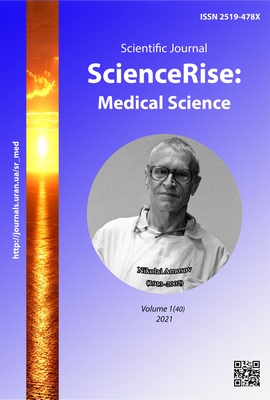Respiratory microbiota disorders in children with neurological disabilities at repeated respiratory diseases
DOI:
https://doi.org/10.15587/2519-4798.2021.224333Keywords:
respiratory microbiota, , repeated respiratory diseases, disabled children, neurological pathologyAbstract
The relevance of the problem of recurrent respiratory diseases in children with severe neurological pathology is due to the high frequency, severity of clinical symptoms and the protracted nature of their exacerbations, as well as the tendency to chronicity of the pathological process.
The aim of the research was to study the respiratory microbiota to optimize antibacterial therapy of recurrent respiratory diseases.
Materials and methods: the 16 children with severe neurological pathology at repeated respiratory diseases were examined. We used a microbiological examination of the upper respiratory tract using a deep smear from the oropharynx to identify a possible causative agent of the disease.
Research results: the pronounced imbalance of the respiratory microbiota, corresponding to II and III degrees of dysbiotic disorders, was revealed in the examined children. The feature of the microflora of the upper respiratory tract was the dominance of Pseudomonas aeroginosa, intestinal opportunistic microflora (Klebsiella pneumoniae, Proteus vulgaris) and their frequent combination with Streptococcus pyogenus, Staphylococcus aureus and yeast-like mushrooms of the Сandida genus. The maximum degree of respiratory microbiota disorders was noted in the group of children with congenital malformations of the brain and correlated with the severity of bronchopulmonary diseases. The analysis of the pathogenic microflora sensitivity to antibiotics showed high resistance of the identified microorganisms to most medicines.
Conclusions: respiratory pathology in children with neurological disabilities is characterized by a recurrent and chronic bronchitis with a tendency of a protracted course which determines the duration of antibiotic therapy. The use of a non-invasive technique for the respiratory microbiota studying makes it possible to identify suspected pathogens of bronchopulmonary diseases and optimize their treatment
References
Metelskaya, V. A., Alshkin, V. A., Voropaeva, E. A., Karaulov, A. V., Nesvizhsky, Yu. V., Afanasyev, S. S. et. al. (2010). Colonization resistance and immunological reactivity of children's oropharyngeal mucosa in health and bronchopulmonary pathology. Annals of the Russian academy of medical sciences, 7, 10–15.
Charlson, E. S., Bittinger, K., Chen, J., Diamond, J. M., Li, H., Collman, R. G., Bushman, F. D. (2012). Assessing Bacterial Populations in the Lung by Replicate Analysis of Samples from the Upper and Lower Respiratory Tracts. PLoS ONE, 7 (9), e42786. doi: http://doi.org/10.1371/journal.pone.0042786
Zakharova, I. N., Kasjanova, A. N., Klimov, L. Y., Kurianinova, V. A., Simakova, M. A. et. al. (2018). Respiratory tract microbiome: what is known today? Pediatrics (Suppl Consilium Medicum), 4, 10–17. doi: http://doi.org/10.26442/24138460.2018.4.180129
Ilchenko, S. I., Duka, E. D., Zhukova, L. A. (2016). Microaspiration Syndrome in Pediatric Practice: Modern Features and Role in Bronchial Obstruction Syndrome Formation. Child`s health, 7 (75), 90–94. doi: http://doi.org/10.22141/2224-0551.7.75.2016.86731
Metelskaia, V. A. (2013). Kharakteristika kolonizatsionnoi rezistentnosti slizistykh obolochek dykhatelnogo trakta pri bronkhitakh u detei. Moscow, 119.
Lupaltsova, O. S. (2014). Osobennosti mikroflory dykhatelnykh putei u detei s respiratornoi patologiei. Sovremennye aspekty infektsionnoi patologii. Astrakhan, 94–99.
Afanasev, S. S., Aleshkin, V. A., Voropaeva, E. A., Afanasev, M. S., Slobodeniuk, V. V., Karaulov, A. V. (2013). Microbiocenoses of open cavities and mucosal immunity. Effektivnaia farmakoterapiia, 1 (27), 6–11. Available at: https://umedp.ru/upload/iblock/87d/2.pdf
Samatova, E. V. (2012). Microbiocenosis Characteristics of the Low Respiratory Tract at Chronic Infectious-Inflammatory Pulmonary Diseases in Children and Antibiotic Resistance of Basic Pathogens. Journal of Ural Medical Academic Science, 1 (38). Available from: http://vestnikural.ru/article/osobennosti-mikrobiocenoza-nijnih-dyhatelnyh-putey-pri-hronicheskih-infekcionno-vospalitelnyh-zabolevaniyah-legkih-detey-i-antibiotikorezistentnost-osnovnyh-patogenov
Kamasheva, G. T., Belukhina, E. G., Sharipova, G. K., Karipollin, B. K. (2011). Kharakteristika mikrobiotsenoza verkhnikh dykhatelnykh putei u chasto boleiuschikh detei g. Semei. Nauka i zdravookhranenie, 1, 69–71.
Huffnagle, G. B., Dickson, R. P. (2015). The bacterial microbiota in inflammatory lung diseases. Clinical Immunology, 159 (2), 177–182. doi: http://doi.org/10.1016/j.clim.2015.05.022
Trinick, R. E., Bunni, L., Thorburn, K., Hackett, A. P., Dalzell, M., McNamara, P. S. (2015). An Observational Study Examining the Relationship between Respiratory Symptoms, Airway Inflammation and Bacteriology in Children with Severe Neurodisability. PLOS ONE, 10 (4), e0124627. doi: http://doi.org/10.1371/journal.pone.0124627
Downloads
Published
How to Cite
Issue
Section
License
Copyright (c) 2021 Елена Сергеевна Коренюк

This work is licensed under a Creative Commons Attribution 4.0 International License.
Our journal abides by the Creative Commons CC BY copyright rights and permissions for open access journals.
Authors, who are published in this journal, agree to the following conditions:
1. The authors reserve the right to authorship of the work and pass the first publication right of this work to the journal under the terms of a Creative Commons CC BY, which allows others to freely distribute the published research with the obligatory reference to the authors of the original work and the first publication of the work in this journal.
2. The authors have the right to conclude separate supplement agreements that relate to non-exclusive work distribution in the form in which it has been published by the journal (for example, to upload the work to the online storage of the journal or publish it as part of a monograph), provided that the reference to the first publication of the work in this journal is included.









